| Subarnarekha River Swarnarekha River | |
|---|---|
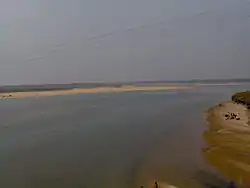 Subarnarekha in December 2005 at Gopiballavpur | |
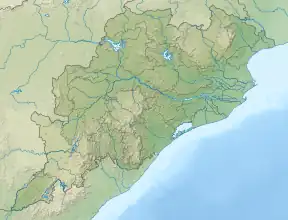 Location of the mouth in India  Subarnarekha River (India) | |
| Location | |
| Country | India |
| State | Jharkhand, Odisha, West Bengal |
| Cities | Ranchi, Chandil, Jamshedpur, Ghatshila, Gopiballavpur, Jaleswar |
| Physical characteristics | |
| Source | |
| • location | Piska/ Nagri(Rani Chuan)near Ranchi, Chota Nagpur Plateau |
| • coordinates | 23°18′N 85°11′E / 23.300°N 85.183°E |
| • elevation | 610 m (2,000 ft) |
| Mouth | Bay of Bengal |
• location | Kirtania port, Odisha, India |
• coordinates | 21°33′18″N 87°23′31″E / 21.55500°N 87.39194°E |
| Length | 395 km (245 mi)[1] |
| Basin size | 18,951 km2 (7,317 sq mi)[1] |
| Discharge | |
| • average | 392 m3/s (13,800 cu ft/s) |
| Discharge | |
| • location | Kokpara[2] |
| • average | 310 m3/s (11,000 cu ft/s) |
| • minimum | 1 m3/s (35 cu ft/s) |
| • maximum | 2,205 m3/s (77,900 cu ft/s) |
| Basin features | |
| Tributaries | |
| • left | Dulang River |
| • right | Kanchi River, Kharkai, Karkari River, Raru River, Garru River |
The Subarnarekha River (also called the Swarnarekha River)[3] flows through the Indian states of Jharkhand, West Bengal and Odisha.
Etymology
As per tradition, gold was mined near the origin of the river at a village named Piska near Ranchi. This is why it was named Subarnarekha, meaning "streak of gold".[4][5] Legend has it that traces of gold were found in the river bed. Even now, people look for traces of gold particles in its sandy beds. The name is a combination of two words meaning gold and line/ streak in Indian languages.[6][7]
Course
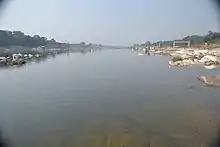
After originating near piska/nagri, near Ranchi, the capital of Jharkhand,[8][9] the Subarnarekha traverses a long distance through Ranchi[10]Seraikela Kharsawan[11] and East Singhbhum[12] districts in the state. Thereafter, it flows for shorter distances through Paschim Medinipur district in West Bengal for 83 kilometres (52 mi) and Balasore district of Odisha. There, it flows for 79 kilometres (49 mi) and joins the Bay of Bengal near Talsari. The total length of the river is 395 kilometres (245 mi).[1]
The basin of the Subarnarekha is smaller than most multi-state river basins in India. The rain-fed river covers a drainage area of 18,951 square kilometres (7,317 sq mi)[1]
Tributaries
.jpg.webp)
The prominent tributaries of the Subarnarekha are Kharkai, Roro, Kanchi, Harmu Nadi, Damra, Karru, Chinguru, Karakari, Gurma, Garra, Singaduba, Kodia, Dulunga and Khaijori.[9] The Kharkai meets the Subarnarekha at Sonari (Domuhani), a neighborhood of Jamshedpur.[13]
Hundru Falls
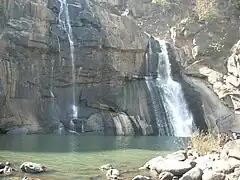
Hundru Falls is created on the course of the Subarnarekha, where it falls from a height of 98 metres (322 ft). The spectacular sight of water falling from such a great height is a sight to behold. The different rock formations due to erosion by the constantly falling water have added to the beauty of the place.[14][15][16]
Pollution
The Subarnarekha passes through areas with extensive mining of copper and uranium ores. As a result of the unplanned mining activities, the river is polluted. The Subarnarekha has been the lifeline of tribal communities inhabiting the Chhotanagpur region and water pollution affects their livelihood. It is getting more pollutants from the aluminium factory of Muri.[5]
Flood
Several areas in the lower reaches of the Subarnarekha, particularly the coastal areas of Odisha and West Bengal, are within the flood hazard zone. The Subarnarekha in Odisha had crossed its previous Highest Flood Level (HFL) of 12.2 metres (40 ft) in 2007, surpassing the earlier record of 1997. In 2009, the Subarnarekha witnessed flash floods following heavy rainfall in the upper catchment areas of the river.[17][18][19] During the flood, large areas of Jaleswar, Bhograi and Baliapal blocks and a small pocket of Basta block in Balasore district of Odisha were affected.[20] Certain areas of Medinipur in West Bengal are also affected by floods.[6]
Projects
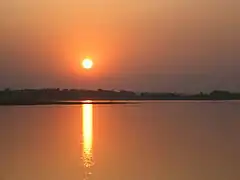
Getalsud
Getalsud reservoir is located across the Subernarekha, 40 kilometres (25 mi) east of Ranchi and about 50 kilometres (31 mi) from its point of origin. Completed in 1971, this multi-purpose reservoir was envisaged mainly to meet municipal water demands of Ranchi city and the adjoining industrial area. The height of the dam is 35.5 metres (116 ft). There are two power houses in Sikidiri with one unit of 65 MW each. Sikidiri Hydal Power Plants are the only hydal projects in Jharkhand.[9]
Subarnarekha multipurpose project
The Subarnarekha multipurpose project envisaged the construction of two dams, one at Chandil across the Subarnarekha and the other across the Kharkai at Icha near Chaibasa, two barrages at Galudih across the Subarnarekha and the other across the Kharkai at Ganjia near Adityapur and a network of canals from these. Three small storage reservoirs and a network of canals from these reservoirs are in Orissa. Started in 1982–83, the multipurpose project was planned for irrigation, hydropower generation and water supply. While the Chandil dam and Galudih barrage are almost complete, the other components are still incomplete.[9][21] Subernarekha Barrage project (West Bengal) envisages construction of a barrage across the Subarnarekha downstream of Chandil dam and Galudih barrage near Bhosraghat to irrigate 114,198 hectares (282,190 acres) annually in the Medinipur district of West Bengal through a left bank canal and its distribution system covering a culturable command area of 96,860 hectares (239,300 acres). The project was taken up for construction in the year 1995–96.[22]
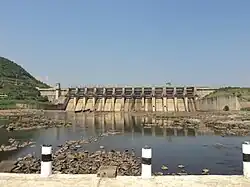
The Chandil Dam and reservoir required 17,028 hectares (42,080 acres) of land. Icha Dam submerged 8,585 hectares (21,210 acres) of land in Jharkhand and 4,415 hectares (10,910 acres) of land in Orissa. The Ganjia Barrage required 266 hectares (660 acres) of land. Galudiha Barrage required 180 hectares (440 acres) of land, of which 150 hectares (370 acres) was private land and 30 hectares was Revenue Land. The canal network required additional land. The project experienced protests from its inception in 1975 and, in 1978, some 10,000 of them demonstrated against the dam at the construction site.[23][24] To address the protests, the government increased the compensation package for 12,000 families and 2,200 people got jobs in different government departments.[25][26]
The construction of Chandil dam, Icha dam and Galudih barrage are complete. This dam is one of the most visited places of Jharkhand. The museum located close to the Chandil dam has scripts written on rocks, which are 2,000 years old.
Subarnarekha port

The Government of Odisha has signed a memorandum of understanding with Chennai-based Creative Port Development Pvt. Ltd. for the development of a deep-water, all-weather project at Kirtania at the mouth of the Subarnarekha. The Kirtania Port project was being taken up on a 50-year build, own, operate, share and transfer (boost) basis. The development would include a dedicated rail cum road connection from the port to the NH 5 and rail network at Jaleswar.[27][28] More recently the project is being referred to as Subarnarekha port. The foundation stone was laid in 2019.[29]
Film
Ritwik Ghatak directed a Bengali film Subarnarekha in 1965. Ghatak's films are deeply haunted by the spectre of the partition of Bengal in 1947. In the film Subarnarekha, Ghatak "has rendered the very idea of home as a sentimental place on an elusive other side that, like the distant, opposing banks of the Subarnarekha River, symbolically represents an idealized, and intranscendible, elsewhere."[30]
References
- 1 2 3 4 "Subarnarekha". Water Resources Information System of India. Retrieved 2014-04-03.
- ↑ "Subarnarekha Basin Station: Kokpara". UNH/GRDC. Retrieved 2013-10-01.
- ↑ "Report on National Aquifer Mapping and Management Plan Parts of Ranchi, Khunti and Lohardagga Districts, Jharkhand" (PDF). Ranchi: Central Ground Water Board. p. 8.
- ↑ "Swarna Rekha in Jharkhand". mapsofindia. Archived from the original on 2009-11-03. Retrieved 2010-04-24.
- 1 2 "Subarnarekha River". rainwaterharvesting. Retrieved 2010-04-24.
- 1 2 "Rivers in Medinipur District". midnapore.in. Retrieved 2010-04-24.
- ↑ "Next weekend you can be at ... Galudih". The Telegraph, 1 May 2005. Archived from the original on May 1, 2005. Retrieved 2010-04-24.
- ↑ "Hydrology and Water Resources Information System - Subernarekha Basin". Retrieved 2010-04-26.
- 1 2 3 4 "River System & Basin Planning" (PDF). Retrieved 2010-04-24.
- ↑ "Ranchi district". District administration. Retrieved 2010-04-26.
- ↑ "Seraikela Kharswan". District administration. Retrieved 2010-04-26.
- ↑ "East Singhbhum". District administration. Retrieved 2010-04-26.
- ↑ "Kharkai River". india9. Retrieved 2010-04-25.
- ↑ "Hundru Falls Ranchi". Maps of India. Retrieved 2010-04-20.
- ↑ "The other side of this industrial city". The Hindu Business Line, 28 July 2003. Retrieved 2010-04-20.
- ↑ "Hundru Falla". District administration. Archived from the original on 2010-01-24. Retrieved 2010-04-20.
- ↑ "Generation of a Coastal Flood Hazard Zonation Map of Midnapur-Balasore Coast in Eastern India using Integrated Remote Sensing and GIS Techniques" (PDF). Department of Geology and Geophysics Indian Institute of Technology, Kharagpur-721302. Retrieved 2010-04-25.
- ↑ "Flood". NRSC Decision Support Centre. Archived from the original on 2010-02-24. Retrieved 2010-04-25.
- ↑ "Subarnarekha, Jalaka flowing above red mark". India Environment Portal. Retrieved 2010-04-25.
- ↑ "Subarnarekha river". Balasore district administration. Archived from the original on 2009-08-22. Retrieved 2010-04-25.
- ↑ Chadha, Ashish (1993). "Subarnarekha Project – Singhbhum's Sorrow". Economic and Political Weekly. 28 (41): 2194–2196. JSTOR 4400253.
- ↑ "Subarnarekha Project". Press Information Bureau. Retrieved 2010-04-24.
- ↑ "Dams, Indigenous Peoples and Ethnic Minorities" (PDF). World Commission on Dams. Archived from the original (PDF) on 2011-06-07. Retrieved 2010-04-24.
- ↑ "DAMS, DISPLACEMENT, POLICY AND LAW IN INDIA" (PDF). Retrieved 2010-04-24.
- ↑ "The Telegraph - Ranchi". www.telegraphindia.com. Archived from the original on September 24, 2015. Retrieved 6 April 2018.
- ↑ "Archived copy" (PDF). Archived from the original (PDF) on 2016-03-04. Retrieved 2014-06-14.
{{cite web}}: CS1 maint: archived copy as title (link) - ↑ "Govt sign MOU to set up port in river Subarnarekha at Kirtania". Archived from the original on 2011-07-25. Retrieved 2010-04-24.
- ↑ "DEVELOPMENT OF PORT AT SUBARNAREKHA". Archived from the original on 2010-03-10. Retrieved 2010-04-24.
- ↑ "Foundation stone laid for Subarnarekha port in Odisha". The Hindu. 14 February 2019. Retrieved 12 February 2020.
- ↑ "Subarnarekha – the Golden Thread, 1965, Ritwik Ghatak". Shooting Down Pictures. Retrieved 2010-04-24.